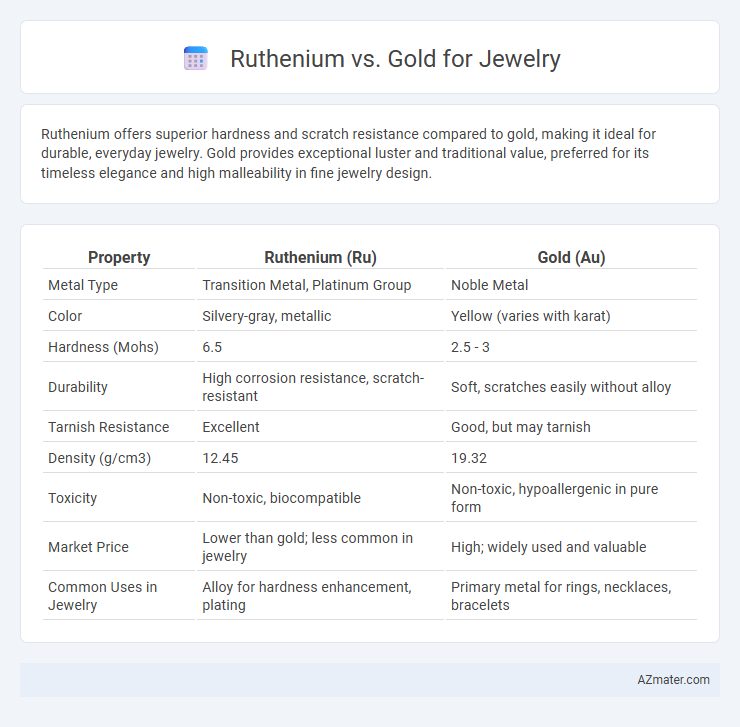Ruthenium offers superior hardness and scratch resistance compared to gold, making it ideal for durable, everyday jewelry. Gold provides exceptional luster and traditional value, preferred for its timeless elegance and high malleability in fine jewelry design.
Table of Comparison
| Property | Ruthenium (Ru) | Gold (Au) |
|---|---|---|
| Metal Type | Transition Metal, Platinum Group | Noble Metal |
| Color | Silvery-gray, metallic | Yellow (varies with karat) |
| Hardness (Mohs) | 6.5 | 2.5 - 3 |
| Durability | High corrosion resistance, scratch-resistant | Soft, scratches easily without alloy |
| Tarnish Resistance | Excellent | Good, but may tarnish |
| Density (g/cm3) | 12.45 | 19.32 |
| Toxicity | Non-toxic, biocompatible | Non-toxic, hypoallergenic in pure form |
| Market Price | Lower than gold; less common in jewelry | High; widely used and valuable |
| Common Uses in Jewelry | Alloy for hardness enhancement, plating | Primary metal for rings, necklaces, bracelets |
Introduction to Ruthenium and Gold in Jewelry
Ruthenium, a rare transition metal in the platinum group, offers exceptional hardness and corrosion resistance, making it an innovative choice for modern jewelry designs. Gold, renowned for its malleability, rich luster, and centuries-old use, remains the industry standard for luxury pieces. The contrasting properties of ruthenium and gold provide jewelers with unique options for durability, color variation, and aesthetic appeal in high-end accessories.
Physical Properties: Ruthenium vs Gold
Ruthenium is a hard, brittle transition metal with a high melting point of 2,334degC, making it more durable and scratch-resistant than gold, which has a lower melting point of 1,064degC and is softer with a Mohs hardness of 2.5-3. Gold's excellent malleability and ductility allow for intricate designs, while ruthenium's rigidity provides enhanced wear resistance in jewelry alloys. The density of gold (19.32 g/cm3) exceeds that of ruthenium (12.45 g/cm3), resulting in heavier and more substantial pieces when using gold in jewelry.
Appearance and Color Differences
Ruthenium jewelry exhibits a dark, gunmetal gray to black finish, offering a modern and edgy alternative to traditional metals. Gold jewelry, available in yellow, white, and rose hues, provides a classic, warm, and lustrous appearance that has been favored for centuries. The stark contrast between ruthenium's sleek, metallic tone and gold's rich, reflective colors allows for diverse stylistic choices in fine jewelry design.
Durability and Wear Resistance
Ruthenium offers exceptional durability and wear resistance, making it highly suitable for jewelry that endures daily use and resists scratches. Gold, especially in higher karats like 18K or 24K, is softer and more prone to bending and surface damage over time. Ruthenium's hardness and resistance to tarnish provide superior longevity compared to gold alloys commonly used in fine jewelry.
Hypoallergenic Qualities and Skin Compatibility
Ruthenium and gold differ significantly in hypoallergenic qualities and skin compatibility, with ruthenium often favored for its resistance to irritation and metal allergies. Gold, especially in higher karats like 18K or 24K, is generally hypoallergenic but can cause reactions when alloyed with nickel or other metals. Ruthenium, a rare platinum-group metal used as a protective coating on gold jewelry, enhances durability and reduces allergic reactions by providing a hypoallergenic barrier against skin contact with allergenic metals.
Price Comparison: Ruthenium vs Gold
Ruthenium offers a significantly lower price point compared to gold, making it an affordable alternative for jewelry without compromising durability or uniqueness. Gold prices fluctuate based on market demand, often remaining substantially higher due to its traditional status and widespread use in fine jewelry. The cost-effectiveness of ruthenium appeals to budget-conscious consumers seeking distinctive pieces that maintain a luxurious appearance.
Popular Jewelry Designs Using Each Metal
Ruthenium is prized in jewelry for its dark, nearly black finish, often used in modern, edgy designs such as sleek bands and geometric shapes that appeal to contemporary tastes. Gold remains the classic choice, renowned for its warm yellow, white, and rose hues, featuring prominently in timeless designs like intricate filigree, solitaire rings, and vintage-inspired necklaces. Both metals serve distinct aesthetic preferences, with ruthenium favored for bold, statement pieces and gold revered for elegant, traditional styles.
Maintenance and Care Requirements
Ruthenium requires minimal maintenance due to its high resistance to tarnishing and scratches, making it ideal for everyday jewelry wear. Gold jewelry, especially in purer forms like 24k, demands regular polishing and protection from chemicals to maintain its luster. Both metals benefit from gentle cleaning with mild soap and soft cloths to preserve their appearance over time.
Environmental Impact and Sustainability
Ruthenium, a rare platinum-group metal, offers a lower environmental impact than gold due to its smaller-scale extraction processes and greater abundance in recycled forms. Gold mining often involves environmentally harmful practices such as cyanide leaching and extensive water use, leading to habitat destruction and pollution. Choosing ruthenium jewelry supports sustainability by reducing reliance on intensive mining and promoting recycling within the precious metals market.
Choosing the Right Metal: Ruthenium or Gold?
Choosing between ruthenium and gold for jewelry hinges on durability, appearance, and budget. Ruthenium offers exceptional hardness, scratch resistance, and a modern, dark metallic finish, ideal for contemporary designs. Gold provides timeless elegance, excellent malleability for intricate craftsmanship, and comes in various purities and colors, making it a versatile and prestigious choice for classic and heirloom pieces.

Infographic: Ruthenium vs Gold for Jewelry
 azmater.com
azmater.com